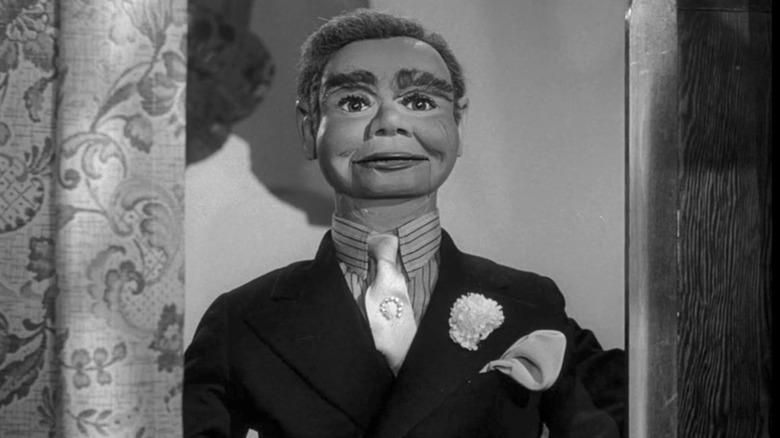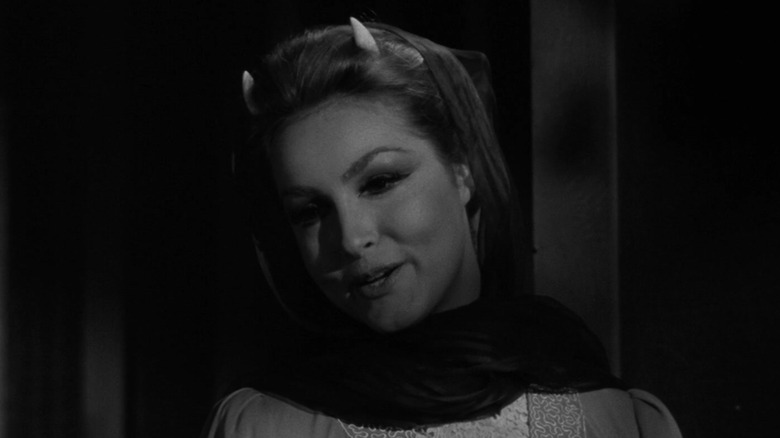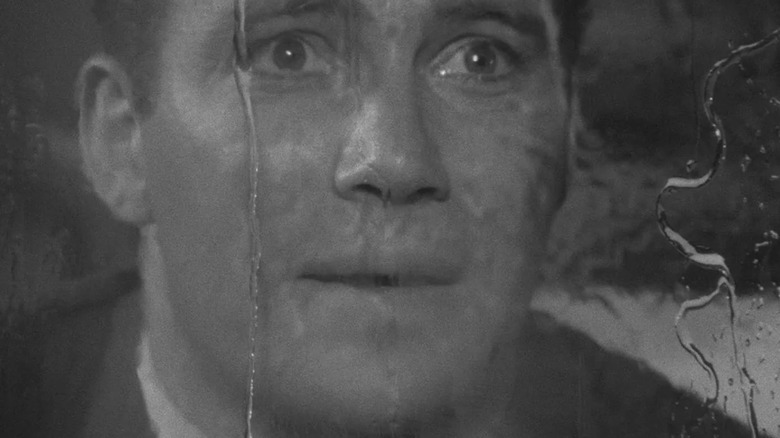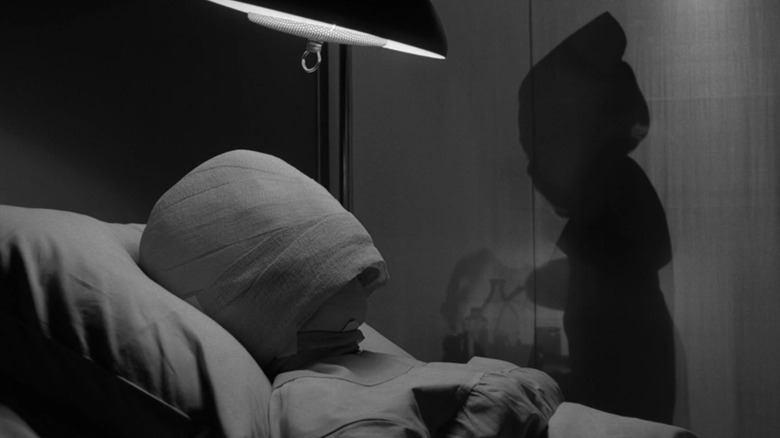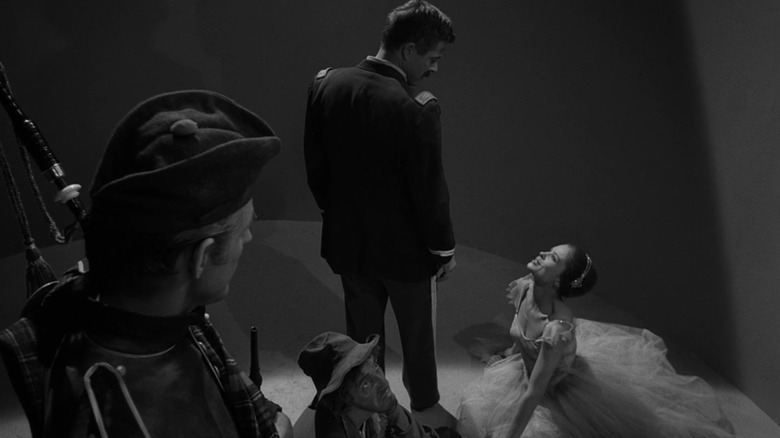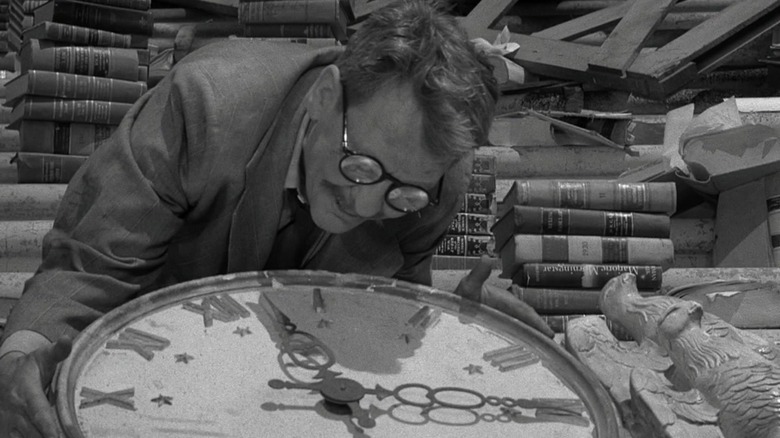Every Season Of The Classic Twilight Zone Series Ranked
Every anthology TV show has high points and low points, and that includes the best one ever made. Rod Serling's seminal 1959 series "The Twilight Zone" broke new ground in small screen storytelling week after week, delivering sci-fi tinged homilies about the human condition. The show looked to the future frequently and to the past more often than you might remember, but its best stories still feel timeless in their acute understanding of fear, loneliness, love, hatred, and mortality. While most shows have a small handful of standout episodes, "The Twilight Zone" has dozens.
And yet, it's not perfect. Any total watchthrough of the series reveals a few distinct flaws, including repetitive plot points and the show's profound inability to pull off more humorous outings. "The Twilight Zone" is a monument in television history, one that's as daring and imaginative as the medium has ever been, but some seasons of it are still better than others. The ranking below takes into account quality, but also consistency and ambition. Some of the show's best episodes aired between two that missed the mark, while other stretches of the show include impressively long streaks of standout after standout. Still, if we were, say, trapped on a desert planet with only one season of "The Twilight Zone" to keep you company, we know exactly which one we'd pick.
5. Season 4
The fourth season of "The Twilight Zone" makes the single worst decision the series ever made, and it's a deceptively simple error. After delivering 102 stories that opened with intrigue and ended with a bang in under 30 minutes, the series decided to experiment with longer episodes. All 18 episodes of the show's penultimate season clock in at nearly an hour, and very few, if any, make full use of that runtime.
This season also includes plenty of ideas that the show had already done better in previous seasons (killer robots, haunted soldiers, devils, and crashed astronauts abound), but it also introduces some of the weirdest and most anemic story concepts of the series. In "Jesse-Belle," a lovestruck witch transforms into a leopard each night. In "I Dream of Genie," a man who finds a magic lamp wishes to become a genie himself. And the less we say about the Shakespeare-invoking finale, the better. The season has precious few acclaimed standouts, though it does feature appearances from Dennis Hopper, Robert Duvall, and Julie Newmar.
Despite the lackluster pacing and recycled plot points, "The Twilight Zone" season 4 is noteworthy for its continued exploration of darker themes than previous seasons. In an episode that tilts more towards horror than science fiction, a wax museum full of serial killer statues comes to life, while another of the season's outings features a neo-Nazi whose rise to power comes courtesy of the specter of Adolf Hitler himself. In that episode, at least, Serling delivers a closing monologue that feels as vital as anything in earlier seasons of the show. "He's alive so long as these evils exist," Serling warns in a speech that borders on an outright call to action. "Remember that when he comes to your town ... Remember it when you hear a name called, a minority attacked, any blind, unreasoning assault on a people or any human being. He's alive because through these things we keep him alive."
4. Season 5
By its final season, "The Twilight Zone" was obviously losing some juice, but the show also ended with a run of episodes that — in a choice that foreshadowed Serling's future series "Night Gallery" — are unapologetically dark. "You Drive" follows a man in the aftermath of a hit-and-run, while a disgruntled husband in "What's in the Box" are haunted by a TV set that shows images of him killing his wife. In a show known for its unhappy endings, season 5 stands out for its ultra-bleak resolutions, like when the aforementioned TV-watching husband is hauled off for murder, or when the little girl in "Caesar and Me" ends up fully under the spell of a living puppet.
The fifth season features sharp and shadowy filmmaking to match its disturbing tone, though its final episode is memorable mostly for its technical problems. An already underwhelming and off-kilter installment, "The Bewitchin' Pool" is made far worse by an awkward redub of one of its child actors. It's a disappointing dud of an ending to a phenomenal series, and it's not the only episode in the season that shows signs of wear. Still, season 5 includes both some all-time greats –- like futuristic beauty standards tale "Number 12 Looks Just Like You" –- and some underrated gems, including the moody death penalty exploration "I Am the Night –- Color Me Black."
Plus, season 5 has something no other season of the series has: William Shatner losing his sh*t about some unseen beast on the wing of a plane. "Nightmare at 20,000 Feet," the episode that sees Shatner gamely take on the role of an increasingly-panicked man convinced he's seen a gremlin aboard his flight, is by far the most-referenced chapter of the entire franchise. Comedies ranging from "Saturday Night Live" to "The Simpsons" to "Ace Ventura" have parodied the episode's most melodramatic scene, while both the 2019 reboot of the show and the ill-fated production "Twilight Zone: The Movie" remade the zeitgeisty story.
3. Season 2
Each of the first three seasons of "The Twilight Zone" is an embarrassment of riches, and every one of them could easily nab the top spot here. The show's second season earns this spot simply because its ratio of bangers to failures is just a hair lower than those that came before and after, but it's still a triumph. Among other series signatures, this season introduced urgent, thrilling theme music by Marius Constant, as well as introductions in which Serling appears on the same set as his characters, often via energetic whip pans and clever reveals.
At this point, the show was mining from classic short stories and Serling's own brain, and both seemed to be endless sources of imagination and pathos. The season's best episodes range from twist-filled dystopian thrillers to riveting stories about mortality and the human condition, and the penultimate episode, "Will the Real Martian Please Stand Up?", even includes a silly-great punchline. That unique story takes the form of a whodunnit in which customers at a diner suspect one another of being aliens, and it's one of several episodes in season 3 that subverts viewer expectations multiple times in its 25 minutes. "The Invaders" similarly breaks the rules of early TV by presenting a nearly wordless story about a woman at a farmhouse fighting aliens, while "Eye of the Beholder" uses its protagonist's limited vision to keep the intrigue surrounding its plastic surgery premise alive.
The best episodes of "The Twilight Zone" pair great acting with impressive visuals and a political or emotional message that hits home, and season 2 features several parables that fit the bill. "The Obsolete Man" uses German Expressionism to tell the story of a librarian made redundant in a totalitarian society, while "Long Distance Call" tells the freaky tale of a dead loved one communicating by toy telephone. Season 2 has its weak spots, but they're usurped wholly by the attention-pulling spectacle of its many high points.
2. Season 3
In terms of sheer influence on pop culture, season 3 of "The Twilight Zone" may be the most noteworthy of the show's run. It features episodes that seem to have inspired everything from "Black Mirror" to "Cube" to "Poltergeist" to the 1978 film "Magic" –- not to mention most every killer doll movie that's come out since then. "The Dummy" is a specific slice of nightmare fuel, but its puppet man is just one of several scary, innocence-shattering images conjured up by "The Twilight Zone" season 3. In "Little Girl Lost," a child gets sucked into a vortex in her bedroom, while "It's A Good Life" features a boy who holds his community in terror thanks to some serious mind control powers.
The show earned an injection of confidence after a successful first season, and it shows in the stories Serling chooses to tell here – and in the starry cast lists. With Peter Falk, Buster Keaton, Robert Redford, Carol Burnett, and Donald Pleasence all stopping by, season 3 brims with talent. An apparently very green Redford gets the distinction of appearing in the quietly touching mortality tale "Nothing in the Dark," which is one of the best episodes of the bunch. It's also one of several great stories in the season that hinges not on a narrative twist, but an emotional one.
While the season has a few unforgettable duds (the silly angel story "Cavender is Coming" and corny cowboy time travel saga "Showdown with Rance McGrew are both among the show's lowest-rated episodes on IMDb), its high points are stunningly high. "To Serve Man" is another alien story with a perfect punchline, while "The Shelter" grounds its human drama in the upsetting, all-too-real hypothetical of an impending nuclear attack. Meanwhile, stylish, existential, and enigmatic fantasy "Five Characters in Search of an Exit" may be the most perfectly rewatchable episode of the entire series –- though to say which holiday marathon you should queue it up for would be to spoil its incredible twist.
1. Season 1
With more than 60 years of retrospect, it's abundantly clear that the best sci-fi show of all time was cooking with gas right out of the gate. In its first season, Serling made the new show with every ounce of commitment and creativity he had to offer, as if he might never get to work in television again. A few obnoxious non-starters aside, the results are some of the most ambitious, surprising, and emotional self-contained stories ever put to the small screen. In total, the first season of "The Twilight Zone" is a potent mix of horror, sci-fi, and humanism that would forever change the face of genre storytelling.
Some of the season's best episodes exist on a continuum that stretches backwards and forwards through time, making them feel like one piece of a larger, decades-spanning storytelling tradition. Jordan Peele's "Us," for example, was inspired in part by Serling's harrowing doppelganger thriller "Mirror Image," and Peele even revived "The Twilight Zone" in 2019. Serling himself adapted several short stories for the first season, turning them into some of the show's earliest PTSD allegories ("And When The Sky Opened") and explorations of the suddenness and injustice of death ("The Hitch-hiker").
The season features roughly a dozen episodes that could be used to illustrate its greatness, from wickedly funny post-apocalyptic tale "Time Enough at Last" (the first of several episodes to feature reliable guest star Burgess Meredith) to capitalism cautionary tale "A Stop at Willoughby." At least one episode, "The After Hours," executes a high-concept story so perfectly that its twist can still catch new viewers off guard to this day, while another — the tense Cold War allegory "The Monsters Are Due on Maple Street" — is perhaps Serling's magnum opus. Whether you're new to the series or rewatching for the 10th time, you can't really go wrong with "The Twilight Zone" season 1; countless viewers still have a great time getting lost in its dimension of imagination to this day.
